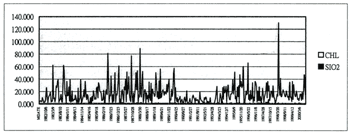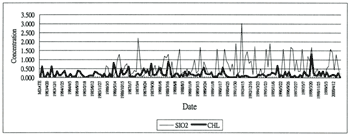|
RELATIONSHIP BETWEEN Si:N RATIOS AND HAB
Silicon (Si) comprises around 5% dry weight of diatoms and so is an essential
element for diatom growth ( Werner, 1977). It has been suggested above that
natural succession and biological competition are the major factors regulating phytoplankton composition
and HAB outbreaks. Si supply is another factor regulating HAB occurrence, but unfortunately, there has
been little research in this area. Long-term monitoring data collected by the Environmental Protection
Department ( EPD, 1991-2001) showed that chlorophyll-a peaks in the
inner portion of Tolo Harbour were not necessarily matched with total number of red tide reports. This
was mainly because most of the chlorophyll-a was contributed by diatoms rather than the red tide causative
dinoflagellates. Instead, on normal days the peaks of chlorophyll-a closely matched peaks of dissolved
silicates in Inner Tolo Harbour (Fig.4). During days of red tide occurrence, however, the level of silicates
was usually low in the seawater, indicating that dinoflagellate growth was frequently promoted by the
exhaustion of silicate supply and the resultant reduction of diatoms (Fig.5). These conclusions were supported
by the fact that in Outer Tolo Harbour and Mirs Bay Water Control Zone, Hong Kong, where diatoms are the
dominant species and red tides rarely occur, the annual mean Si:N ratio was often greater than 1 or closely
equivalent to 1. Furthermore, Liu et al. (2002) found that the Si:N and Si:P
ratios in Tolo Harbour have been gradually increased since 1991, resulting in increased prominence and
increased overall cell concentrations of diatoms.
| (Enlarge: 55KB) |
 |
Figure 4. Changes of surface chlorophyll-a (mg/L, shaped black) and silicates
(mg/L, white lines) in the Inner Tolo Harbour (1982-2000) during normal sampling days
| (Enlarge: 42KB) |
 |
Figure 5. Changes of surface chlorophyll-a (g/L) and silicate (g/L) in the
Inner Tolo Harbour (1982-2000) during red tides
If silicon plays an important role in regulating the growth of diatoms, which consequently affects the phytoplankton community structure and the possible outbreak of dinoflagellate blooms, the detailed ecological and physiological mechanisms need further research.
Several researchers proposed that allelopathy is involved in the succession
of phytoplankton community. The phenomenon of allelopathy was defined as the harmful effect of one alga
on a second alga by means of a chemical compound liberated into the environment
(Darley, 1982). Kakisawa et al. (1988) showed that an allelopathic
substance isolated from a brown alga, namely Cladosiphon okamuranus, affected 36 species of microalgae,
including Chaetoceros debile, and destroyed their cell structure in 30 minutes. Recent studies
by Hiromi (2002) also showed that the inhibition of Heterosigma akashiwo
growth was due to allelo-chemicals produced by a diatom, namely Cylindrotheca closterium. Unfortunately,
no comprehensive research on allelopathy has been conducted in Hong Kong. Liu and
Wu (2002) however found that a strain of Chattonella marina isolated from the Hong Kong water
was able to produce a significant concentration of reactive oxygen species (ROS), and the ROS might be
responsible for gill damage and then kills of local cultured fishes ( Tang and Au,
2002). Wu and Lee (2002) also reported that the growth of Chattonella
marina was inhibited when the alga was exposed to 50 μW/cm 2 of UV-B and
40 μW/cm 2 of UV-A irradiance for 12 hours for several days. The growth inhibition
might be due to photo-inhibition or inactivation of nitrogenase within C. marina. Hence, further
research in the interactions between allelopathic chemicals, environmental factors and interspecific competition
on phytoplankton community is a challenge to scientists who intends to clarify the formation mechanism
of HABs in Hong Kong and the South China.
According to the present research findings, besides the discharge of domestic sewage and agricultural wastes, which contain a very large quantity of TIN and DIP, variation of Si input due to urbanization, soil erosion and river diversion could be an other cause of increased red tides in enclosed coastal waters. The relevant implications to control, management and mitigation of HABs worthy is to concern.
CONCLUSION
While most of the harmful algal blooms (HABs) in Hong Kong were triggered by special geographic, oceanographic and climatic conditions, dinoflagellate-caused HABs were closely associated with nutrient supplies. In particular, the variation of N:P (atomic) ratio plays an important role in supporting algal biomass. Based on review of the literature and analysis of long-term monitoring data in Hong Kong, it is proposed that dinoflagellate-related HABs are regulated by two major factors: (a) the threshold concentrations of TIN (generally 0.1 mg-N/L) and DIP (generally 0.02 mg-P/L) and, (b) the N:P (atomic) ratios (mostly 4-16). The Redfield Ratio should be critically reviewed in terms of its application to HABs dominated by dinoflagellates in coastal waters.
Recent research indicates that interspecific competition between diatoms and dinoflagellates, with particular reference to natural succession and the relevant demands for nutrients by diatom, dinoflagellate and micro-flagellate communities, also plays a regulating role in HAB occurrence.
Silicon (Si) concentration limits the optimal growth of diatoms, thus regulating the dominant species in the phytoplankton community. Generally speaking, diatom blooms are favored by larger N:P (atomic) ratios (often >22) and a Si:N (atomic) ratio close to or greater than one. The implications of this conclusion are worth further in-depth analysis.
ACKNOWLEDGEMENT
The authors would like to thank the Director of Environmental Protection Department, Government of the Hong Kong Special Administration Region, China for permission to use his department's marine water quality monitoring data for statistical analyses and interpretation. The opinions in this paper are those of the authors and do not necessarily reflect the views or policies of the Government of Hong Kong Special Administration Region.
|